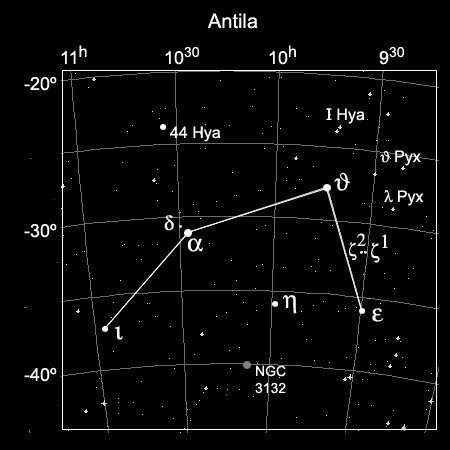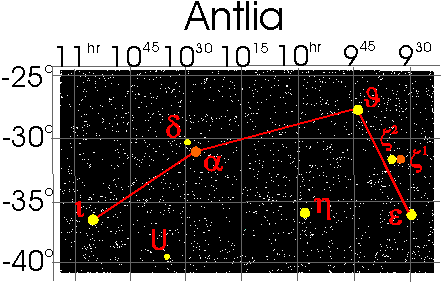
Antlia is a fairly obscure late-Winter early-Spring constellation far to the south of Regulus (alpha Leonis). It contains very little of interest for binoculars, apart from the optical binary zeta1-zeta2. Confirm that you have indeed found the constellation's brightest star, alpha Antliae, then go off and visit the two zetas. It would be very helpful though, if you've studied Puppis or Hydra first.

Alpha Antliae is an orange giant 365 light years away; the brightest star in the constellation at 4.3 visual magnitude. The star is fairly south (-31º) so may not raise terribly high above the horizon if you live in the northern hemisphere. If you studied Puppis, you'll recall how you found that constellation using the southeastern stars of Canis Major. Now, locate p Puppis once again then move directly east three full 'hours' (45º). (You'll go through Pyxis, which is between Puppis and Antlia). After two-thirds of this journey you'll meet zeta1 Antliae and zeta2 Antliae, which are 30º east of Puppis. Alpha Antliae is another 15º to the east.
If you've investigated Hydra, it might be more convenient to follow Hydra's form down from alpha Hydrae (Alphard), which is the dominant star in this part of the sky. You'll recall that mu Hydrae is southeast of Alphard. Once you've found mu Hydrae drop due south 14º or two full FOVs.
Zeta1 and zeta2 Antliae form an optical binary of similar stars, 6.2 and 5.9 magnitudes, both 115 light years away; the two are easily split with binoculars.
Zeta1 has a close companion, suitable for telescopes: 6.2, 7.0; PA 212º and separation 8". The two zetas are two binocular fields west of alpha Antliae.
